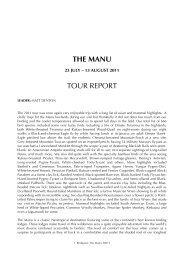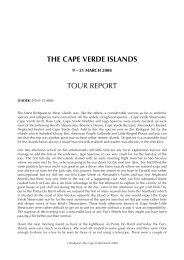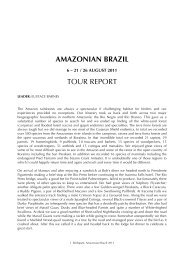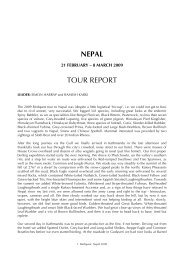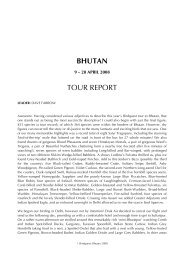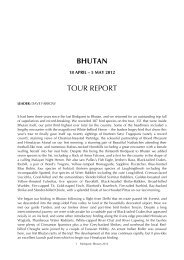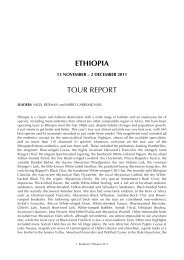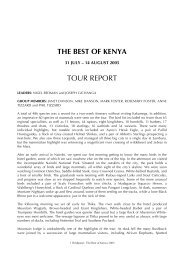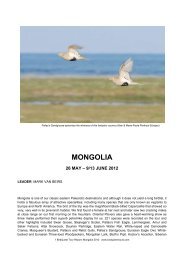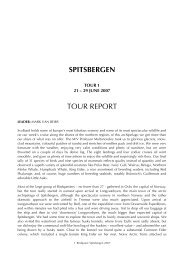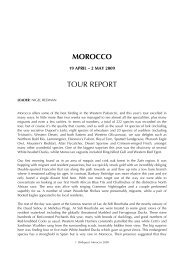INDONESIA (LESSER SUNDAS) REP 10 - Birdquest
INDONESIA (LESSER SUNDAS) REP 10 - Birdquest
INDONESIA (LESSER SUNDAS) REP 10 - Birdquest
You also want an ePaper? Increase the reach of your titles
YUMPU automatically turns print PDFs into web optimized ePapers that Google loves.
On our first morning of the tour, before what was scheduled to be a relatively early flight to Sumba,<br />
we had time to do some birding in the Benoa Harbour area. It was still quite a high tide when we<br />
arrived, but soon began to fall, exposing shorebird habitats at relatively close range. A very large<br />
congregation of egrets was impressive, and the small groups of Sunda Teal included three adult birds<br />
with two tiny chicks. There were also very good numbers of both Gull-billed and Little Terns, with<br />
many juveniles of the latter. A few Javan Plovers were found as usual, though mostly rather distant,<br />
and amongst the numerous Lesser Sand-plovers, we picked out at least two Greaters. Other<br />
shorebirds included Eurasian Curlew, Bar-tailed Godwit, Grey-tailed Tattler, and several Terek<br />
Sandpipers. Savanna Nightjars showed ridiculously well as usual and there were at least five Small<br />
Blue Kingfishers, as well as four Sacreds. Island Collared Dove and Javan Myna were seen in flight.<br />
As usual, the flight to Sumba was late and we also had to fly via Kupang. Somehow though, we still<br />
managed to arrive at the Yumbu Grasslands to search for our first endemic, Sumba Buttonquail, at the<br />
usual time! It was good to see long grass at the old site this year and, no sooner had we formed a line<br />
and started to work through the grass, than we flushed two of our targets. We spent the best part of<br />
the next hour trying to get views on the ground and the best possible looks in flight. Several<br />
surprisingly good views were had of them on the ground as they scuttled from grass clump to clump,<br />
a good result. Other introductory birds included plenty of Australasian Bushlarks, several Zebra<br />
Finches, and some good looks at Indonesian Honeyeater. Both Spotted Kestrel and Peregrine Falcon<br />
(the latter of a small dark resident form) were also seen.<br />
Due to some changes in the itinerary, our first morning on Sumba was spent at the lakes and marshes<br />
of Menggitimbe, to the east of Waingapu. This year we walked around the main lake, which was<br />
relatively dry and also visited two smaller lakes which are part of the same complex. Two rarities<br />
were seen this time, a juvenile Swamp Harrier, one of the first to have ever been seen in Asia, and<br />
two Glossy Ibis. More typical were good numbers of Wandering Whistling-ducks and Pacific Black<br />
Ducks. There were relatively few shorebirds, but we had better views of about 30 Javan Plovers, a<br />
nice flock of 25 Long-toed Stints, and two Australian Pratincoles. After flushing a Savanna Nightjar at<br />
close range from a dry stony area, Jürgen was lucky enough to spot the two well-grown chicks that it<br />
had been tending, a fantastic sight. A couple of singing Australian Reed-warbler also showed well in<br />
the tall marsh vegetation.<br />
After lunch in Waingapu, we drove to our new accommodation at the homestay in Lewa, and in the<br />
afternoon began our exploration of forest nearby. Although it was cloudy and there were some faint<br />
showers, there was good bird activity. The first endemic to fall by the wayside was the beautiful Rednaped<br />
Fruit-dove. The second was, more surprisingly, Sumba Flycatcher, one of the most difficult<br />
endemics, that decided to give itself up easily for a change. Next up were a couple of Sumba Jungleflycatchers,<br />
giving only average views, and a pair of Apricot-breasted Sunbirds. Then four Sumba<br />
Hornbills appeared on a small ridge and a pair were scoped for a lengthy period; more were seen in<br />
flight later. Just before dusk, we taped-in a lovely Cinnamon-banded Kingfisher, which sat for a long<br />
time in full view. As the sky darkened, we positioned ourselves for Sunda Nightjar, and were soon<br />
getting prolonged close views of three, including one perched. As soon as darkness fell, a pair of the<br />
fairly recently described Little Sumba Boobook began calling, and we were lucky to obtain a string of<br />
good views in the spotlight. All-in-all, it had been a superb start.<br />
Our second day on Sumba saw us heading off early to look for Citron-crested Cockatoo at<br />
Watumbelar. Unfortunately the site that we were taken to wasn’t a good one for this endangered bird.<br />
However it did prove very good for Marigold Lorikeet which we saw very nicely perched, and we<br />
also saw Great-billed and Eclectus Parrots. More Sumba Hornbills appeared, as did Red-naped Fruitdove,<br />
and other goodies included a pair of Sumba Brown Flycatchers (one of which was carrying<br />
food), a pair of Sumba Flycatchers, scope views of Wallacean Cuckoo-shrike and Pale-shouldered<br />
Cicadabird, and much better views of Apricot-breasted Sunbird and Blood-breasted Flowerpecker.<br />
Red-backed Buttonquail was heard booming from a grassy hillock. After lunch and a quick nap we<br />
2 <strong>Birdquest</strong>: The Lesser Sundas 20<strong>10</strong>




